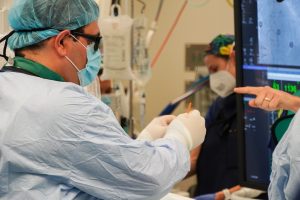Adelaide researchers, Professors Leonie Heilbronn and Gary Wittert, have discovered that restricting meal timing to daylight hours can help to restore circadian rhythm and improve metabolic health.
This first-in-human evidence has important implications for the health of shift workers and people with metabolic conditions such as type 2 diabetes.
Restoring rhythm
Restricting eating within an 8-10-hour window each day for 8 weeks realigned metabolism and blood sugar regulating hormones to the natural circadian rhythm in obese men at risk of metabolic disease.
“In principle, we know from animal studies that there is a food-entrained rhythm and here we’ve shown that in humans you can restore that rhythm by eating on cue,” said Professor Gary Wittert, Senior Consultant Endocrinologist at the Royal Adelaide Hospital and Director of the Freemasons Centre for Male Health and Wellbeing based at the South Australian Health and Medical Research Institute.
Altering this food and light entrained circadian rhythm can have major impacts on health and disease.
As well as various cancers such as breast and prostate cancer, shift workers are more likely to develop obesity and metabolic syndrome: a cluster of conditions including type 2 diabetes.
Manipulating meal timing may be a practical way to prevent disease in shift workers and to augment the health management of people with obesity and metabolic syndrome.
In this study, time-restricted eating altered the expression of CLOCK genes, which exist in all cells and align the function of cells with the 24-hour light-dark cycle.
What does this mean?
The results of the study imply that shift workers may benefit from keeping a normal daytime eating schedule, despite having unusual waking hours, although this has not been experimentally proven yet.
For now, what’s clear is that importance of eating on a typical daytime schedule.
“I tell all of my patients who have or are at risk of diabetes to restrict their eating to align with the light-dark cycle. I think there is enough evidence to do that practically,” said Professor Wittert.
Strength in numbers
This ground-breaking study was possible thanks to collaboration from the Central Adelaide Local Health Network, the South Australian Health and Medical Research Institute, the University of South Australia and The University of Adelaide.
“The outcomes of studies of this sort and the ability to do studies of this sort, require the collaboration of clinicians and basic scientists and vice versa. That is a key point,” reflected Professor Wittert.
More on the research
Click here to read the research paper.
The next step in this line of work is to repeat this study over a prolonged period.



